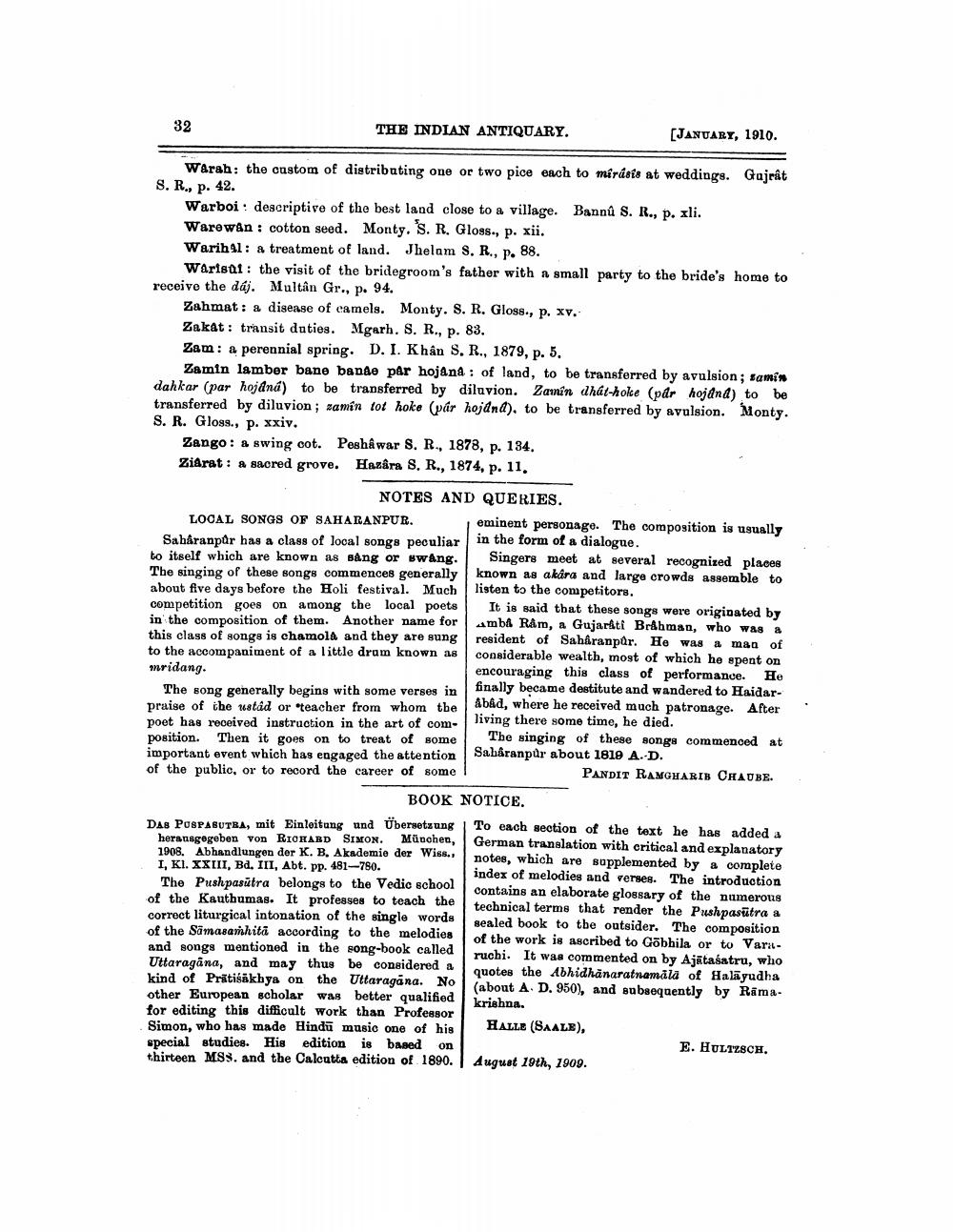________________
32
THE INDIAN ANTIQUARY.
(JANUARY, 1910.
Warah: the custom of distributing one or two pice each to mérásis at weddings. Gajrât S. R., p. 42.
Warboi : descriptive of the best land close to a village. Bannû S. R., p. xli. Warewan : cotton seed. Monty, s. R. Gloss., p. xii. Warihil: a treatment of land. Jhelum S. R., p. 88.
Warisat: the visit of the bridegroom's father with a small party to the bride's home to receive the daj. Multân Gr., p. 94.
Zahmat: a disease of camels. Monty. S. R. Gloss., p. xv. Zakat: transit duties. Mgarh. S. R., p. 83. Zam: a perennial spring. D. I. Khân S. R., 1879, p. 5.
Zamin lamber bane bande par hojana : of land, to be transferred by avulsion; samin dahkar (par hojdná) to be transferred by diluvion. Zanin dhát-hoke (par hojdnd) to be transferred by diluvion; namin tot hoke (pár hojdnd), to be transferred by avulsion. Monty. S. R. Gloss., p. xxiv.
Zango : & swing cot. Peshậwar S. R., 1878, p. 184. Ziarat: a sacred grove. Hazara S. R., 1874, p. 11.
NOTES AND QUERIES. LOCAL SONGS OF SAHARANPUR. eminent personage. The composition is ugually Saharanpur has a class of local songs peculiar in the form of a dialogue. to itself which are known as sång or swang. Singers meet at several recognized places The singing of these songs commences generally known as akára and large crowds assemble to about five days before the Holi festival. Much listen to the competitors. competition goes on among the local poets It is said that these songs were originated by in the composition of them. Another name for amba Ram, a Gujarati Brahman, who was a this class of songs is chamold and they are sung resident of Saharanpur. He was a man of to the accompaniment of a little drum known as considerable wealth, most of which he spent on mridang.
encouraging this class of performance. He
finally became destitute and wandered to HaidarThe song generally begins with some verses in praise of the ustad or teacher from whom the
Abad, where he received much patronage. After poet has received instruction in the art of com
living there some time, he died. position. Then it goes on to treat of some
The singing of these songe commenced at important event which has engaged the attention Sabaranpur about 1819 A.-D. of the public, or to record the career of some
PANDIT RAMGHARIB CHAUBE.
BOOK NOTICE. DAS PUSPABUTBA, mit Einleitung und Übersetzung To each section of the text he has added a herausgegeben von RIORARD SIMON. München, German translation with critical and explanatory 1906. Abhandlungen der K. B, Akademie der Wiss.,
notes, which are supplemented by a complete I, KI. XXIII, Bd. III, Abt. pp. 481-780.
index of melodies and verses. The introduction The Pushpasūtra belongs to the Vedic school
contains an elaborate glossary of the numerous of the Kauthumas. It professes to teach the
technical terms that render the Pushpastatra a correct liturgical intonation of the single words
sealed book to the outsider. The composition of the Sämasaṁhità according to the melodies
of the work is ascribed to Cõbbila or to Varaand songs mentioned in the song-book called
ruchi. It was commented on by Ajitasatru, who Uttaragāna, and may thus be considered a
quotes the Abhidhānaratnamåla of Halāyudha kind of Pritisakhya on the Uttaragāna. No
(about A. D. 950), and subsequently by Rimaother European scholar was better qualified
krishna. for editing this difficult work than Professor Simon, who has made Hindū music one of his
HALLE (SAALE), special studies. His edition is based on
E. HULTZSCH. thirteen Mss. and the Calcutta edition of 1890. August 19th, 1909.




